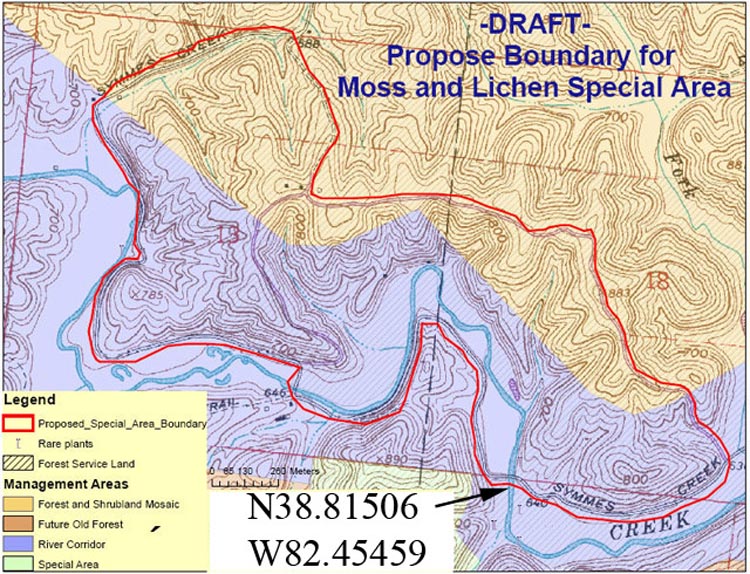OMLA 2008 Spring Foray
Symmes Creek, Gallia County, OH (June 21, 2008)
In partnership with the West Virginia Native Plant Society, the Ohio Moss and Lichen Association (OMLA) visited an area of the Wayne National Forest in Gallia County that is especially rich in lichens and mosses. This area is under consideration for designation as a protected lichen and moss study area. 
OMLA and West Virginia Native Plant Society at Symmes Creek, Gallia Counbty, Ohio. June 21, 2008.
Proposed Moss and Lichen Special Area in Wayne National Forest, Symmes Creek, Gallia County, Ohio.
The arrow and geographic coordinates show where we parked and walked in along the Creek. We scaled some bluffs in the woods. There is some steep relief, a sandstone bluff, where mosses and lichens are abundant.

Sandstone rock outcrop near Symmes Creek, Gallia County, Ohio, June 21, 2008.
One of the more intriguing mosses growing here is Diphyscium foliosum (family Diphysciaceae), seen on soil at the base of the bluff, in fairly dense shade. Unlike most mosses, which have their spore capsules elevated on a thin stem-like stalk, the capsules of Diphyscium are nearly stalkless, simply sitting practically on the ground surrounded by a few small leaves. According to Howard Crum in Mosses of the Great Lakes Forest, the sloping shape of the tilted capsules causes spores to be expelled in little puffs when the capsules get pelted by raindrops. Evidently the spores can fly two inches in this manner, accounting for the common name “powder puff moss.” Crum also mentions that the great bryologist William Steere has said that Diphyscium looks like “scared rabbits in the grass.”

Diphyscium foliosum at Symmes Creek proposed moss and lichen special area.
Gallia County, June 21, 2008.
Although this is one of our most distinctive mosses when it is “in fruit” (the useful but very inaccurate term for a moss that is bearing sporophytes), sterile Diphyscium can be tricky to ID. The strap-shaped leaves, sometimes growing quite densely, can mislead you into thinking it’s in the family Pottiaceae. The leaves are distinctly dark, almost blackish, when dry. The woodsy, often acidic, habitat is a good clue.
Growing on the bark of a small slanted dead wood sapling is a lichen Parmotrema hypotropum, the powdered ruffle lichen.

Parmotrema hypotropum lichen, Symmes Creek area, Gallia County, Ohio, June 21, 2008
Another distinctive lichen is a “rock tripe,” Umbilicaria mammulata. The rock tripe lichens are large leathery wrinkled discs attached to the tops and sides of rock outcrops and boulders.

Rock tripe lichen, Umbilicara mammulata, on the side of a sandstone boulder,
Symmes Creek area, Gallia County, Ohio, June 21, 2008.
Growing on top of this huge rock tripe-adorned boulder are several mosses and a reindeer lichen. One of the most abundant mosses here is strictly a dry rock-top species, commonly found on granitic or sandstone-based rocks, but not often calcareous ones, Hedwigia ciliata. Hedwigia displays a growth form very similar to the fruticose (shrubby) lichen, Cladina subtenuis against which it is snuggled. This Cladina is an example of a “reindeer ‘moss’,” related to arctic forms that are indeed staples of reindeer and caribou.

Hedwigia ciliata moss and Cladonia subtenuis (reindeer ‘moss’) atop boulder.
Symmes Creek area, Gallia County, Ohio, June 21, 2008.

Dicranum spurium and Hypnum imponens atop sandstone boulder.
Gallia County, Ohio. June 21, 2008.

OMLA members examining corticolous cryptogams at the Spring foray in Gallia County, June 21, 2008.
Because this was a one-day foray, we didn’t have an evening lab ID session. Members took specimens home for identification. So far, we have the following mosses confirmed: Steerecleus serrulatus, Hypnum imponens, Haplocladium microphyllum, Bryoandersonia illecebra, Mnium affine var. cilare, Pylaisia intricata, Anomodon attentuatus, Dicranum scoparium, and Atrichium undulatum (in the broad sense, as several forms of Atrichum previously considered varieties of A. undulatum are now recognized as species).
If you were on the foray, please submit your identifications for a more complete list in the next issue of OBELISK.
Lichens Recorded During the OMLA Summer Foray, Symmes Creek Site, Gallia County
* = new county record
Anaptychia palmulata
Canoparmelia crozalsiana
C. texana*
Cladina subtenuis
Cladonia furcata
C. squamosa
C. uncialis
Collema subflaccidum
Dermatocarpon luridum
Flavoparmelia baltimorensis
F. caperata
Heterodermia speciosa
Hypotrachyna livida
H. showmanii
Imshaugia aleurites
Lasallia papulosa
Leptogium cyanescens
Myelochroa aurulenta
M. galbina
Parmelia sulcata
Parmelinopsis minarum
Parmotrema hypotropum
P. stuppeum
P. xanthinum
Phaeophyscia pusilloides
P. rubropulchra
P. squarrosa
Physcia americana
P. millegrana
P. subtilis
Punctelia missouriensis
P. rudecta
P. subrudecta
Pyxine sorediata
P. subcinerea
Umbilicaria mammulata
Usnea amblyoclada
Xanthoparmelia conspersa
Bryophytes Recorded During the OMLA Summer Foray, Symmes Creek Site, Gallia County
* = new county record
Mosses
Anomodon attenuatus
A. rostratus
Atrichum tenellum*
Aulacomnium heterostichum
Brachythecium oxycladon
B. plumosum
Bryoandersonia illecebra
Bryum caespiticum*
Callicladium haldanianum*
Dicranum fulvum
D. scoparium
D. spurium
Entodon seductrix
Fissidens minutulus* (was form of F. bryoides)
Grimmia laevigata*
Haplocladium virginianum*
Hedwigia ciliata
H. curvifolium
H. pallescens*
Isopterygiopsis muelleriana*
Leucobryum glaucum
Orthotrichum pumilum
Plagiomnium ciliare* (previous record historic only)
P. cuspidatum*
Plagiothecium denticulatum
Platygyrium repens
Polytrichum ohioense
Pseudotaxiphyllum distichaceum*
P. elegans
Rhynchostegium serrulatum* (= Steerecleus serrulatus)
Sematophyllum demissum
Thuidium delicatulum
Tortula obtusifolia* (= Desmatodon obtusifolius)
Trichostomum tenuirostre* N (= Oxystegus tenuirostris)
Liverworts
Jamesoniella autumnalis*
Lophocolea cuspidata
Lophocolea heterophylla
Ptilidium pulcherrimum*
Scapania nemorea

